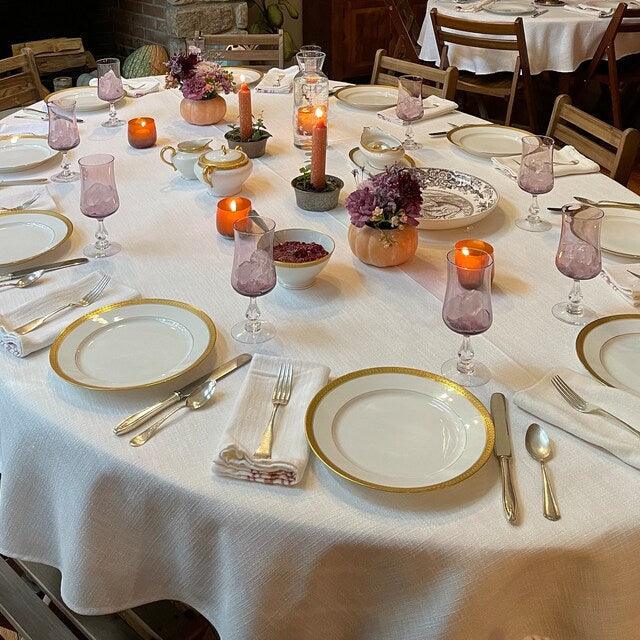Bed Linen Fabric Advancements: Discovering Modern Trends and Creative Applications in Design and Textile Industry
From lasting production techniques to cutting-edge weaving innovations, the advancement of bed linen is improving the landscape of the textile industry. As we dive right into the worlds of innovative layout applications and the development of bed linen blends and hybrid fabrics, a new phase unfolds in which bed linen's function in future fabric developments takes center phase.
Sustainable Practices in Linen Production
Sustainable methods in linen production have actually come to be progressively vital in the fabric market's initiatives to lessen environmental influence and advertise moral sourcing techniques. Bed linen, a natural fiber obtained from the flax plant, provides a variety of benefits such as breathability, biodegradability, and longevity. However, conventional approaches of linen production can involve substantial water usage, pesticide usage, and energy-intensive processes.
To deal with these challenges, several fabric suppliers are embracing lasting practices throughout the bed linen production process. This consists of sourcing flax from organic farms that stay clear of hazardous pesticides and chemicals, implementing water-efficient retting techniques to essence fibers from the flax stalks, and using environment-friendly dyes and coatings. Additionally, some business are purchasing renewable resource resources to power their manufacturing centers and minimizing waste through recycling and upcycling initiatives.
Technical Innovations in Bed Linen Weaving
With the growing focus on sustainable techniques in linen production, the fabric industry is currently observing a rise in technological advancements specifically aimed at changing the art of linen weaving. These technologies are improving the method linen textiles are generated, offering increased effectiveness, high quality, and imagination in weaving techniques.
Among the key technological advancements in linen weaving is the assimilation of electronic looms. These innovative looms are geared up with software application that enables for complicated and intricate styles to be woven with precision. By digitizing the weaving process, manufacturers can attain greater consistency and precision in their linen textiles.
In addition, advancements in yarn spinning modern technology have allowed the production of finer and more long lasting linen threads - table cloths. This results in softer and smoother linen materials that keep their high quality even after several usages and washes
Furthermore, the development of environmentally friendly dyeing procedures and surfaces for bed linen materials is acquiring traction. These sustainable practices not just reduce the ecological influence yet likewise deal with the enhancing customer need for morally generated textiles.
Creative Layout Applications for Linen
Cutting-edge creative methods are progressively forming the innovative design applications for linen in the fabric market. Linen's natural aesthetic allure and ability to mix with other materials make it a favored option for producing unique garments and accessories that provide to the ecologically conscious consumer.
Furthermore, designers are try out bed linen in home decoration, utilizing its durable and breathable nature to craft elegant furnishings such as curtains, bedding, and furniture. The appearance and drape of bed linen bring a sense of refinement and comfort to indoor spaces, including a touch of beauty to contemporary homes.

Bed Linen Blends and Crossbreed Fabrics
:max_bytes(150000):strip_icc()/Bonnie-Phil_24-a9b5c05b6b684ff4a67f4c4b36cc9404.jpg)
Crossbreed materials, on the other hand, take the idea of mixing an action additionally by integrating additional components such as metallic threads, recycled products, or conductive fibers. These ingenious fabrics not just expand the style possibilities but additionally introduce useful elements like conductivity, antimicrobial homes, or enhanced longevity. Hybrid textiles are significantly being utilized in numerous markets, including style, interior layout, and technical fabrics, where the demand for multifunctional products gets on the increase.
Bed linen's Role in Future Fabric Innovations

In the realm of future fabric technologies, linen is expected to be a principal in the growth of advanced practical fabrics. Developers and researchers are exploring methods to improve bed linen's integral qualities through technological advancements, such as incorporating wise fabrics, nanotechnology, and efficiency surfaces. These technologies intend to boost bed linen's efficiency characteristics, making it ideal for a broader range of applications, from activewear to protective clothes.
In addition, the mix of bed linen with various other natural or synthetic fibers opens up unlimited possibilities for creating novel textiles with unique homes and performances. By leveraging linen's characteristics and exploring ingenious blends, the textile market is poised to present exciting advancements that accommodate evolving consumer demands and sustainability needs.
Final Thought
To conclude, the exploration of lasting techniques, technical developments, creative layout applications, bed linen blends, and its role in future textile advancements highlight the continual evolution of bed linen textile in the contemporary design and fabric market. With a concentrate on technology and creative thinking, the adaptability and green nature of bed linen make it an important product for producers and designers alike, leading the way for more advancements and advancements in the area of textiles.
As we dive into the realms of imaginative style applications and the emergence of bed linen blends and hybrid materials, a new chapter unravels in which linen's function in future textile advancements takes center stage.
Discovering the combination of bed linen with various other fabrics has actually led to the emergence of cutting-edge blends and hybrid textiles in the modern textile market. Bed linen blends provide an one-of-a-kind combination of the attributes of linen with those of other fibers, resulting in textiles that possess enhanced residential or commercial properties such as boosted resilience, improved draping, and reduced wrinkling.The evolution of linen blends and crossbreed materials has set the stage for Bed linen to play a critical function in driving future fabric innovations.In the realm of future fabric technologies, linen is expected to be a crucial gamer in the growth of Get More Information advanced practical materials.